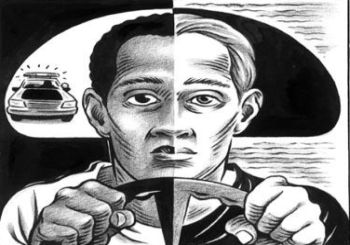Oblivious

BY ARYEH MELLMAN
The shooting of Michael Brown is just one example of the notion that in a myriad of ways in their everyday lives, people with black skin are treated differently than people with white skin. But don’t just take it from me: ask President Obama, who remarked in a speech about Trayvon Martin that “there are very few African Americans who haven’t had the experience of getting on an elevator and a woman clutching her purse nervously and holding her breath until she had a chance to get off. That happens often.” Or ask the family of Jordan Davis, the 17-year-old who was shot and killed because a (white) man in the car next to him thought his music was too loud.
If you don’t trust these one-off stories to prove a discrepancy between treatment of whites and blacks in this country, look at the statistical evidence. One study found that while someone with a specific resume and a white-sounding name (like Greg or Emily) had to send out ten resumes to get a callback, someone with the exact same resume but a black sounding name (like Lakisha or Jamal) had to send out fifteen resumes to get a single callback.
Not only are African-Americans less likely to get jobs than their equally qualified white counterparts, they are more likely to be incarcerated for the same crimes. Despite using marijuana at roughly the same rates as whites, blacks are about four times more likely to be arrested for marijuana use nationally, and in some states, up to eight times more likely.
Yet neither the anecdotes nor the hard statistics change the minds of white Americans. Just 16 percent of whites believe that there is a “lot” of discrimination in today’s America, compared with 56 percent of blacks, a worldview wholly at odds with the evidence presented above. The 40-acre-and-a-mule question, then, is why don’t whites realize the extent to which racial discrimination still exists in our society?
One answer can be found in our schools. According to historian James Loewen, a man whose mission is improving historical pedagogy high school students consistently rank history as their least favorite subject and the vast majority of them don’t take another history class after high school. This dearth of education leaves them with high school conceptions of history, in which the focus is on memorizing hundreds of key terms, rather than understanding broader historical contexts and trends.
The result of this poor learning of history is that students know history as a series of terms and events that operate in a vacuum, perhaps leading to one another in a straight line. For example, to most (white) students, slavery gave way to emancipation, which then led to the civil rights movement and its dual legislative victories (the Civil Rights and Voting Rights Acts). Then, with the election of a black president, racism was formally abolished from American society. Though this narrative is an oversimplification, it is close to accurate for the majority of white Americans who are oblivious to contemporary African-American life. It fails to connect and account for the GI Bill and New Deal policies which largely excluded blacks, and racist housing policies like redlining (the systematic denial of loans, mortgages, and other services to residents of a racially homogenous area) that preyed on blacks and deeply affect African-American society to this day.
This lack of understanding about history would seem to be easily curable; just talk to black friends about their lives! But even that is easier said than done. The Public Religion Research Institute found that, assuming he or she has 100 friends, the average white person has 91 white friends, eight friends of other races, and a single black friend. The lack of communication on a personal level undoubtedly contributes to the gaps in white understanding of black experiences.
Because they don’t learn about it sufficiently in our classes, and because they have so few black friends to discuss the racial divide with, whites just don’t understand why blacks see everything as a “race issue.” It’s an easy claim to make; whites generally don’t experience “race issues”. They drive their cars without fear of getting pulled over, smoke weed without fear of getting arrested, and walk the streets of their neighborhoods without fear of being shot by the police or the neighborhood watchmen who are supposed to protect them.
The story of race in America isn’t all negative. Painstakingly slowly, strides have been made. Overtly racist attitudes are no longer accepted in mainstream society, whereas they were once openly held by our elected leaders; consider Donald Sterling’s swift excommunication from the NBA by 29 white (and one black) owners and a white commissioner. But we must not allow the absence of overt racism to conceal the legacy of racism that continues to poison this country after 400 years. There are fundamental differences in the way that blacks and white grow up and see the world, and we must strive to do all we can to bring that difference down to nothing.